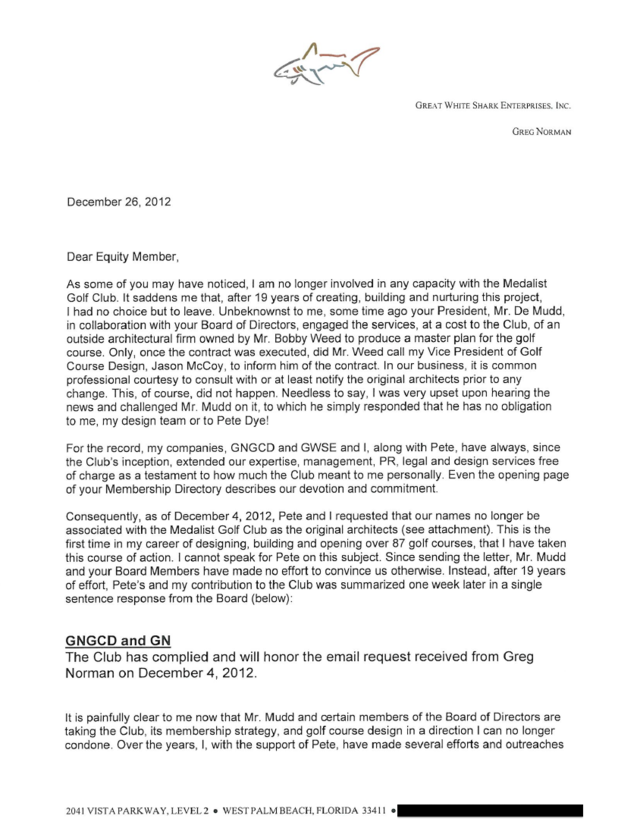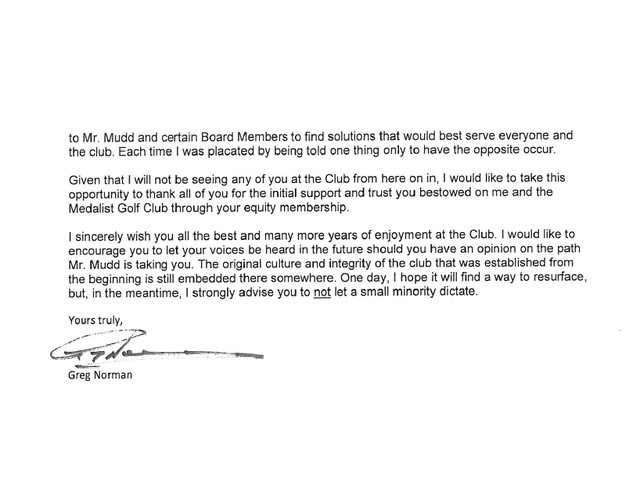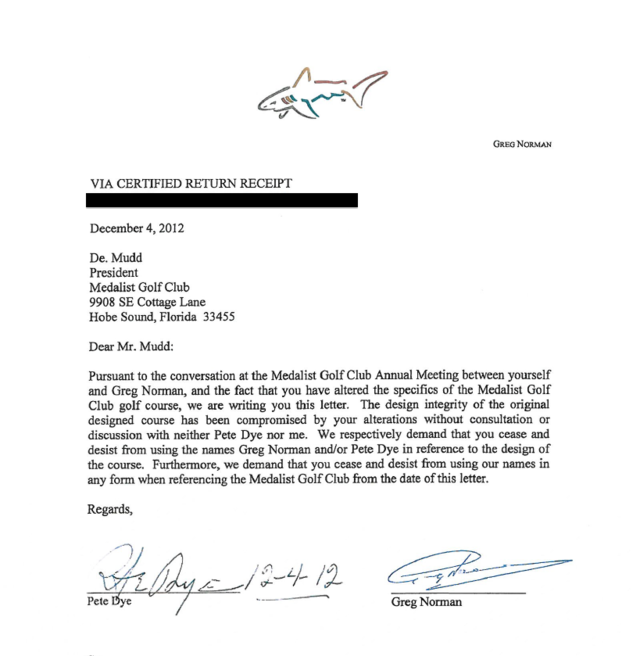Greg Norman's Letter To Medalist Members
/I think the most interesting thing about Greg Norman's goodbye letter making the email rounds after going to Medalist equity members is the attached third page. Co-designer Pete Dye signed on to take his name off the design as well, even though protege/co-designer Bobby Weed has been hired to probably restore much of Dye's original work.
But I did get a nice chuckle of the Shark's dramatization of the whole affair first revealed by Tim Rosaforte, especially of the supposed courtesy call that architects make when they replace another architect.
Who says the Shark doesn't have a sense of humor?
Page 1 (click to enlarge):
Page 2: (click to enlarge):
**From reader Jeff Lewis, a Medalist member and Golf Magazine panelist:
Hi Geoff,
I'd like to try to bring this sorry tale to a close, or at least back to architecture.
Let's start with the club's history and Norman's part in it. He and Tucker Frederickson, the ex-Giant, did something extraordinary when they started Medalist. They created a culture of fun and of respect for good quality golf that is pretty much unparalleled today in my experience. Most, if not all, of the board Norman is railing against today, are people who were attracted to the club in the early days by the culture they created. I have played a few hundred courses I would rather play than Medalist, but I don't know a club I'd rather belong to, and Norman and his original partners have a large part in that.
The original course was certainly the best course Norman has ever had a part in designing. I wasn't there to tell anybody which parts were designed by whom. Most assume that it was Dye's genius that created that original course, but really nobody has any idea what part each of them played in creating the first Medalist.
It was an amazing place. Difficult, yes. But also distinctive, and strategic.
The strategy of the course bore many Pete Dye hallmarks. Off the tee it was quite testing because most tee shots had hazards on the inside of the elbows. That's where hazards test one's nerve. Either we try to fly them, right into their guts and get the benefit, or we wimp out and take the long way home. The beauty of the original Medalist was that if you lost your nerve a bit off the tee, you went right through the fairway on the outside of those elbows. Some said that was a "weakness" of the original course. I saw good design. Perhaps we needed the three foot strip of second cut we have today back in the mid-90s to keep that straggling ball out of the waste, but all in all, those were phenomenal shots we faced off the tee.
And the greens. Much has been made of the sod-walled bunkers, straight out of the UK, that were apparently a maintenance problem. Maybe they were, but they were Gorgeous. And the best part of them was the green complexes in which we found them. They were low profile gems, right at the level of the fairway, begging for approach shots that landed short of the front edge. Plus, from around the original greens, every club in the bag was in play. Somebody described the course as "Greg Norman's British Open practice facility" 15 years ago and I thought what a privilege it is to play at such a place. I recall that lots of folks used to complain when they landed a ball pin high and it bounced over. But virtually every green was open in front and the course was marked to the front edge. If you couldn't figure out the type of shot to play, that wasn't the designers' fault.
Then, mysteriously, something started to happen. I don't know if members complained, or if prospective purchasers of real estate were intimidated, but suddenly everything that was impressive architecturally about Medalist started to change. The hazards off the tee moved from the inside to the outside of the elbows. Your brain, and your nerve were no longer tested on the tee shots. Now a tee shot that takes the cowardly line ends up in a bunker, instead of the pine straw and the brush.
And the greens, oh the greens. Somebody started pushing them up away from the level of the fairways, removing the opportunities for different types of shots. Suddenly, a few years after the course opened "Greg Norman's British Open practice facility" had vanished. The sod walls were gone, the low profile greens were gone and we were left with a great club with an amazing routing, a fantastic membership, and a thoroughly ordinary golf course.
I totally applaud any effort to bring back the course to its original Pete Dye/Greg Norman design as I am sure most who appreciate original, quality architecture would. I don't care whose name is on it. I just want the 5th, 6th, 10th, 11th, 13th, 15th, 16th, 17th and 18th holes back.
About 4 or 5 years ago I started a thread on Golf Club Atlas about "The youngest course to ever need a restoration" because the original Medalist was gone. Well, she's 5 years older now, and maybe progress is coming. And thank goodness for that, whoever does it and whoever gets the credit.














